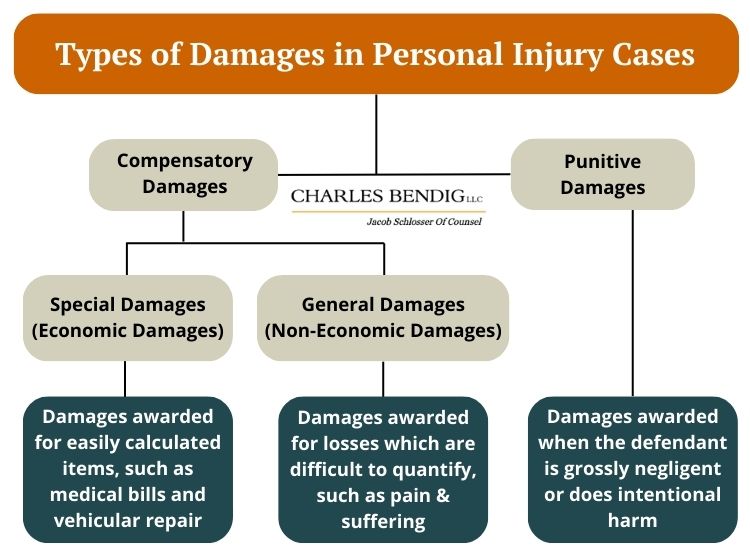In the realm of personal injury claims, the term “damages” signifies the financial compensation that a plaintiff seeks through legal action. These damages aim to alleviate the hardships caused by an injury or harm, aiming to restore the injured individual to their pre-incident condition.
We understand the importance of comprehending the various types of damages available in personal injury cases, especially here in Columbus, Ohio.
Types of Personal Injury Damages
In personal injury cases, there are three primary types of damages:
- Special Damages
- General Damages
- Punitive Damages
While special and general damages are commonly grouped as ‘compensatory damages’, each serves a distinct purpose in addressing the losses incurred by the injured party.
Let’s go over each of these.

What Are ‘Compensatory Damages’?
Compensatory damages are intended to do just what the name says, “compensate” the injured party for the losses they’ve suffered due to the injury.
These damages come in two forms: special and general.
Special damages – encompass measurable economic losses, such as medical bills and lost wages. These expenses directly correlate with the financial impact of the injury on the plaintiff.
Examples of Special Damages
– Medical Bills: Costs incurred for necessary medical care.
– Rehabilitation Costs: Expenses related to therapy and recovery.
– Lost Earnings: Income lost due to missed work.
– Property Damage: Costs for repairing or replacing damaged property.
– Out-of-Pocket Expenses: Additional costs resulting from the injury.
How Are Special Damages Calculated?
Calculating special damages involves a thorough evaluation of all economic losses stemming from the injury. Detailed records of expenses, including medical bills and lost wages, are essential for an accurate assessment.
General damages – address non-economic losses that are not easily quantifiable, such as pain and suffering or loss of enjoyment of life.
Examples of General Damages
– Pain and Suffering: Physical discomfort endured due to the injury.
– Emotional Distress: Psychological impact caused by the injury.
– Loss of Enjoyment of Life: Impairment of daily activities and hobbies.
– Disfigurement or Physical Impairment: Permanent changes resulting from the injury.
How Are General Damages Calculated?
Calculating general damages involves considering various factors, including the severity and duration of pain and suffering, emotional impact, and impact on daily life.
What Are ‘Punitive Damages’?
Punitive damages, also known as exemplary damages, are awarded to punish the defendant for reckless or intentional misconduct. These damages serve to deter similar behavior in the future.
Examples of Punitive Damages
– Gross Negligence: Extreme carelessness resulting in harm.
– Fraud: Intentional deception causing injury.
– Defamation: False information damaging reputation.
– Malicious Conduct: Intentional harm inflicted on the plaintiff.
– Violations of Rights: Egregious disregard for the plaintiff’s rights.
How Are Punitive Damages Calculated?
The calculation of punitive damages considers the severity of misconduct, harm caused, defendant’s financial status, and comparative case law.
A personal injury attorney can get you the full amount of compensation possible.
If you’ve been injured due to someone else’s negligence, you may be entitled to compensatory and punitive damages. Charles Bendig is dedicated to helping you navigate the complexities of your case. We offer free consultations and personalized guidance to ensure you receive the justice and compensation you deserve.
Reach out to us today to discuss your case and explore your legal options. Your journey toward justice begins with us.





